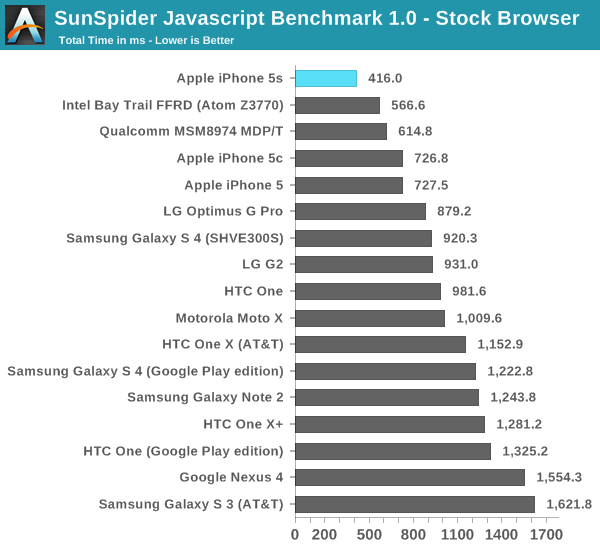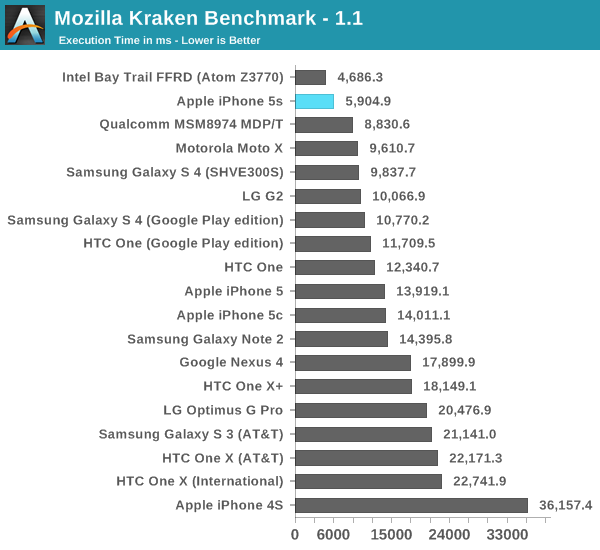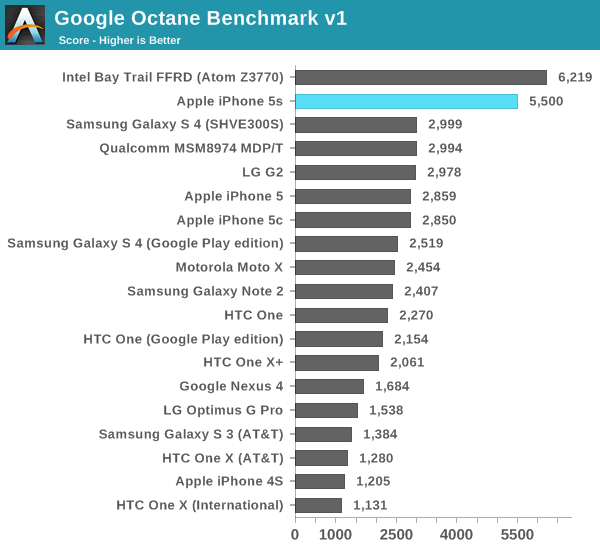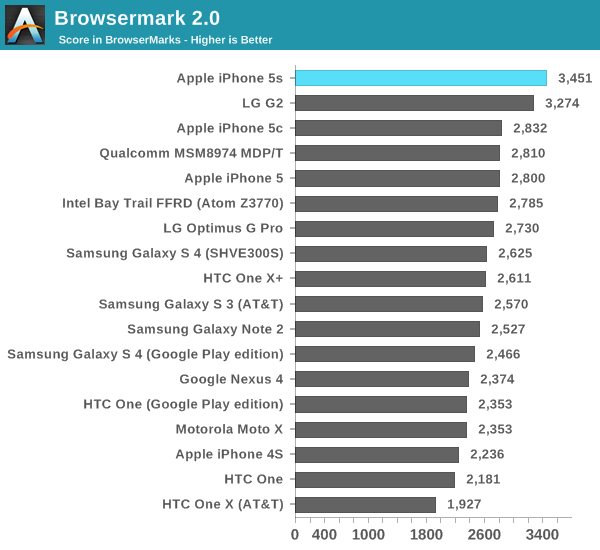The iPhone 5s Review
by Anand Lal Shimpi on September 17, 2013 9:01 PM EST- Posted in
- Smartphones
- Apple
- Mobile
- iPhone
- iPhone 5S
CPU Performance
For our cross-platform CPU performance tests we turn to the usual collection of Javascript and HTML5 based browser tests. Most of our comparison targets here are smartphones with two exceptions: Intel's Bay Trail FFRD and Qualcomm's MSM8974 Snapdragon 800 MDP/T. Both of those platforms are test tablets, leveraging higher TDP silicon in a tablet form factor. The gap between the TDP of Apple's A7 and those two SoCs isn't huge, but there is a gap. I only include those platforms as a reference point. As you're about to see, the work that Apple has put into the A7 makes the iPhone 5s performance competitive with both. In many cases the A7 delivers better performance than one or both of them. A truly competitive A7 here also gives an early indication of the baseline to expect from the next-generation iPad.
We start with SunSpider's latest iteration, measuring the performance of the browser's js engine as well as the underlying hardware. It's possible to get good performance gains by exploiting advantages in both hardware and software here. As of late SunSpider has turned into a bit of a serious optimization target for all browser and hardware vendors, but it can be a good measure of an improving memory subsystem assuming the software doesn't get in the way of the hardware.

Bay Trail's performance crown lasted all of a week, and even less than that if you count when we actually ran this benchmark. The dual-core A7 is now the fastest SoC we've tested under SunSpider, even outpacing Qualcomm's Snapdragon 800 and ARM's Cortex A15. Apple doesn't quite hit the 2x increase in CPU performance here, but it's very close at a 75% perf increase compared to the iPhone 5. Update: Intel responded with a Bay Trail run under IE11, which comes in at 329.6 ms.
Next up is Kraken, a heavier js benchmark designed to stress more forward looking algorithms. Once again we run the risk of the benchmark becoming an optimization target, but in the case of Kraken I haven't seen too much attention paid to it. I hope it continues to fly under the radar as I've liked it as a benchmark thus far.

The A7 falls second only to Intel's Atom Z3770. Although I haven't yet published these results, the 5s performs very similarly to an Atom Z3740 - a more modestly clocked Bay Trail SKU from Intel. Given the relatively low CPU frequency I'm not at all surprised that the A7 can't compete with the fastest Bay Trail but instead is better matched for a middle of the road SKU. Either way, A7's performance here is downright amazing. Once again there's a performance advantage over Snapdragon 800 and Cortex A15, both running at much higher peak frequencies (and likely higher power levels too, although that's speculation until we can tear down an S800 platform and a 5s to compare).
Compared to the iPhone 5, the 5s shows up at over 2.3x the speed of last year's flagship.
Next up is Google's Octane benchmark, yet another js test but this time really used as a design target for Google's own V8 js engine. Devices that can run Chrome tend to do the best here, potentially putting the 5s at a disadvantage.

Bay Trail takes the lead here once again, but again I expect the Z3740 to be a closer match for the A7 in the 5s at least (it remains to be seen how high the iPad 5 version of Cyclone will be clocked). The performance advantage over the iPhone 5 is a staggering 92%, and obviously there are big gains over all of the competing ARM based CPU architectures. Apple is benefitting slightly from Mobile Safari being a 64-bit binary, however I don't know if it's actually getting any benefit other than access to increased register space.
Our final browser test is arguably the most interesting. Rather than focusing on js code snippets, Browsermark 2.0 attempts to be a more holistic browser benchmark. The result is much less peaky performance and a better view at the sort of moderate gains you'd see in actual usage.

There's a fair amount of clustering around 2500 with very little differentiation between a lot of the devices. The unique standouts are the Snapdragon 800 based G2 from LG, and of course the iPhone 5s. Here we see the most modest example of the A7's performance superiority at roughly 25% better than the iPhone 5. Not to understate the performance of the iPhone 5s, but depending on workload you'll see a wide range of performance improvements.










464 Comments
View All Comments
ddriver - Wednesday, September 18, 2013 - link
I mean, only a true apple fanboy is capable of disregarding all that technical argumentation because of the mention of the term "apple fanboys". A drowning man will hold onto a straw :)akdj - Thursday, September 19, 2013 - link
You consider your comment 'technical argumentation'? It's not....it's your 'opinion'. I think you can rest assured Anand's site is geared much more to those of us interested in technology and less interested in being a 'fanboy'. In fact....so far reading through the comments, you're the first to bring that silly cliché up, "Fan Boy".A drowning man will hold on to anything to help save himself :)
Wilco1 - Wednesday, September 18, 2013 - link
Good comment - I'm equally unimpressed by the comparison of a real phone with a Bay Trail tablet development board which has significantly higher TDP. And then calling it a win for Bay Trail based on a few rubbish JS benchmarks is even more ridiculous. These are not real CPU benchmarks but all about software optimization and tuning for the benchmark.Single threaded Geekbench 3 results show the A7 outperforming the 2.4GHz Bay Trail by 45%. That's despite the A7 running at only 54% of the frequency of Bay Trail! In short, A7 is 2.7 times faster than BT and on par/better than HasWell IPC...
tech4real - Wednesday, September 18, 2013 - link
not trying to dismiss A7's cpu core, it's an amazing silicon and significantly steps up against A6, but is there a possibility that the geekbench3 is unfit to gauge average cross-ISA cross-OS cpu performance... To me, the likelihood of this is pretty high.Wilco1 - Wednesday, September 18, 2013 - link
Comparing different ISAs does indeed introduce inaccuracies due to compilers not being equal. Cross OS is less problematic as long as the benchmark doesn't use the OS a lot.It's a good idea to keep this in mind, but unfortunately there is little one can do about it. And other CPU benchmarks are not any better either, if you used SPEC then performance differences across different compilers are far larger than Geekbench (even on the same CPU the difference between 2 compilers can be 50%)...
Dooderoo - Wednesday, September 18, 2013 - link
"The AES and SHA1 gains are a direct result of the new cryptographic instructions that are a part of ARMv8. The AES test in particular shows nearly an order of magnitude performance improvement".Your comment: "in reality the encryption workloads are handled in a fundamentally different way in the two modes [...] a mixed bad into one falsely advertising performance gains attributed to 64bit execution and not to the hardware implementations as it should"
Maybe actually read the article?
"The FP chart also shows no miracles, wider SIMD units result in almost 2x the score in few tests, nothing much in the rest"
Exclude those test and you're still looking at 30% improvement. 30% increase in performance from a recompile counts at "nothing much" in what world?
ddriver - Wednesday, September 18, 2013 - link
My point was encryption results should not have been included in the chart and presented as "benefits of 64bit execution mode" because they aren't.Also those 30% can easily be attributed to other incremental upgrades to the chip, like faster memory subsystem, better prefetchers and whatnot. Not necessarily 64bit execution, I've been using HPC software for years and despite the fact x64 came with double the registers, I did not experience any significant increase in the workloads I use daily - 3D rendering, audio and video processing and multiphysics simulations. The sole benefit of 64bit I've seen professionally is due to the extra ram I can put into the machine, making tasks which require a lot of ram WAY FASTER, sometimes 10s even 100s times faster because of the avoided swapping.
Furthermore, I will no longer address technically unsubstantiated comments, in order to avoid spamming all over the comment space.
Dooderoo - Wednesday, September 18, 2013 - link
"Furthermore, I will no longer address technically unsubstantiated comments, in order to avoid spamming all over the comment space."Man, you give up too easily.
Encryption results are exactly that: "benefits of 64bit execution mode". Why? 32-bit A32 doesn't have the instructions, 64-bit A64 does. Clear and obvious benefit.
"30% can easily be attributed to other incremental upgrades to the chip". Wouldn't the 32-bit version benefit from those as well?
I'm beginning to think you don't understand that those results are both from the A7 SOC, once run with A32 and once with A64.
ddriver - Wednesday, September 18, 2013 - link
""30% can easily be attributed to other incremental upgrades to the chip". Wouldn't the 32-bit version benefit from those as well?"This may be correct. Unless I am overlooking execution mode details, of which I am not aware, and I expect neither are you, unless you are an engineer who has worked on the A7 chip. I don't think that data is available yet to comment on it in detail.
But you are not correct about encryption results, because it is a matter of extra hardware implementation. It is like comparing software rendering to hardware rendering, a CPU with hardware implementation of graphics will be immensely faster at a graphics workload, even if it is the same speed as the one that runs graphics in software. If anything, the architecture upgrades of the A7 chip can at best result in 2x peak theoretical performance improvement, while the AES test shows 8+x improvement. This is because the performance boost is not due to 64 bit mode execution, but due to the extra hardware implementation that is exclusively available in that mode.
Dooderoo - Wednesday, September 18, 2013 - link
"I don't think that data is available yet to comment on it in detail."Yet you're ok with calling the article "cunningly deceitful"? Weird.